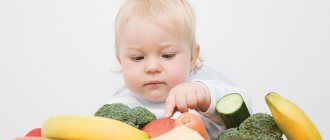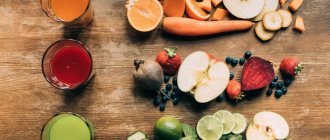At 1 year and 3 months (15 months), the child develops his own food preferences. During this period, it is important to accustom your baby to healthy and varied dishes in the diet. Diet, food quality, culinary processing and a smooth transition from pureed to solid foods remain important.
Photo: Depositphotos.com. Author: iakovenko123.
Required Products
Let's start with those that should appear on the children's table every day.
Milk and its derivatives
Source of animal protein, vitamins and calcium.
Total volume of breast milk or adapted formula, kefir, yogurt and other dairy products: 500 ml per day.
- Breastfeeding is not canceled. Mom can feed the baby 1-2 times a day early in the morning and at night. As the needs of the child's body change, the quantity and quality of breast milk change. Therefore, the child is not in danger of overeating.
- The adapted mixture is given only one feeding, which can be replaced with 200 ml of kefir or fermented milk mixture before bedtime.
- Cottage cheese (the daily value does not exceed 50 g) is offered in its pure form or used to prepare steamed cheesecakes, puddings, and soufflés.
- Kefir or yogurt is given up to 200 ml per day. Choose products with live lactic acid bacteria and marked “for baby food.”
Porridge
Sources of slow carbohydrates, B vitamins and minerals.
Gluten-containing representatives appear in the diet: wheat, oatmeal, millet porridge with milk or water (≈200 g).
For children with poor weight gain, you can also prepare semolina porridge 1-2 times a week, but without fanaticism: it contains phytins, which impede the absorption of calcium and vitamin D.
Meat
Meat products are rich in proteins and amino acids, B vitamins, and iron.
Lean pork, domestic chicken, rabbit, beef and veal are on the menu 4-5 times a week, 80 g per serving in the form of cutlets, meatballs, meatballs, soufflé.
Vegetables
Suppliers of vegetable protein, vitamins, fiber and minerals.
Used for preparing fresh salads, stewing, and added to soups.
These are cabbage, zucchini, beets, carrots, pumpkin, tomatoes and cucumbers.
Total amount per day: 200 g.
The exception is mashed potatoes with a high starch content, which is given no more than 2 times a week.
Fruits and berries
They refresh, tone, teach you to chew food, and have a rich vitamin and mineral profile.
Fresh apples, pears, bananas are served in a nibbler. Plums, apricots, peaches, and cherries are offered without seeds or skin.
From berries: raspberries, white and black currants, cranberries, lingonberries, blueberries, gooseberries.
A 15-month-old child needs 100 g per day from a fruit and berry basket.
Eggs
Dietary protein product, source of essential amino acids and vitamins.
Only chicken and quail eggs after heat treatment are allowed on the children's menu.
Standard: ½ chicken egg (white and yolk) or a whole quail egg. It is allowed to give every other day, increasing the amount by 2 times.
Oil
Provides the growing body with vitamins A, E, D and valuable fatty acids.
The share of vegetable oil is a quarter of the total amount or 5–6 g per day, butter is 15 g.
Bread
In the children's diet, the leader is easily digestible white bread made from wholemeal flour (40 g per day). Up to 20 g of rye bread is also allowed.
Beverages
Children's bottled water is offered unboiled. From other sources (well, water supply, borehole) requires boiling.
The child’s body itself regulates the need for water depending on the temperature and physical activity. Therefore, it must be given on demand.
Compotes, juices, fruit drinks
Prepared from fruits and berries typical of the place where you live, without adding sugar.
Dried fruits and fruits frozen for future use are also suitable for compotes.
Fish
It is recommended to use fish dishes in children's diets once or twice a week. Children under one and a half years old are allowed such types of fish as cod, hake or pollock, pike perch, sea bass, but if the child is allergic, it is worth giving up fish until at least 2-3 years. Fish can be offered in the form of children's specialized canned fish, fish soufflé, boiled fish with a side dish, or steamed cutlets.
Fish is good for children because of its easily digestible protein and a set of vitamins and microelements, iodine and fluorine, phosphorus and calcium, useful for the growth of skeletons and teeth. But, at this age, soups with fish broth are strictly prohibited - extractive and harmful substances from the fish carcass pass into the broth during cooking.
Products that are given irregularly
By-products
Liver, tongue, heart are sources of protein, vitamin B12, iron, essential amino acids.
Offal stewed with vegetables (50 g) or pate replaces one meat dish once a week.
When can liver be included in the children's menu?
Fish
Saturates the children's body with proteins, fatty acids, vitamin D, phosphorus and calcium.
Lean inhabitants of the seas (pollock, hake, cod) are valued for the absence of small bones and parasites.
Fish fillet is offered to the baby 2 times a week, 60 g each. It is boiled, stewed with vegetables or rolled into minced meat for cutlets and meatballs.
Pasta
Small vermicelli, horns and small stars from durum wheat are given no more than 2 times a week. The restriction is due to the high calorie content and low nutrient content.
Boiled pasta is served as a side dish with cheese or cottage cheese, in a volume of no more than 100 g, and is used to season vegetable and milk soups.
Not recommended for overweight children.
Cheese, sour cream, cream
5 g of cheese in porridge, salads or on a piece of bread is enough.
Sour cream or cream, 10 g, is added to prepared soups no more than 2-3 times a week.
Sweets
Occasionally, you can pamper your baby with sweets from the shelves of dietary departments, which contain fructose: white marshmallows, marshmallows.
A good option is a spoonful of homemade jam for cottage cheese, cheesecakes or porridge.
Please note! Acceptable sugar intake: 35 g per day, taking into account its content in other products (milk, cereals, fruits, vegetables, etc.).
How can marshmallows benefit children?
Salt
Can be harmful: it causes fluid retention and increases the load on the kidneys.
Vegetables, fruits, grains and meat cope well with salt deficiency under the age of 3 years.
Make it a rule: give your baby food that is under-salted (by adult standards), do not exceed the permissible daily allowance of 1.5 g, add salt at the end of cooking.
At what age can a child be given salt?
Children's nutrition rules
Children's bodies require sufficient nutrients to thrive and grow. Pediatricians give the following advice on creating a menu for a baby at 1 year 3 months:
- During the day, the child should eat at least 5 times.
- The daily diet should include fresh fruits, vegetables, soup, meat and fish dishes.
- It is better to alternate fish and meat. You can make two days a week fish days, the rest meat days.
- Avoid fried foods completely. They are poorly digestible in children and can cause a feeling of heaviness and bowel movements.
- When choosing meat, it is better to give preference to rabbit, veal, turkey, and chicken.
- Choose low-fat fish.
- Eggs can be given no more than 2 times a week.
- Do not include prohibited foods in your diet.
- Use low-fat sour cream and vegetable oil as a dressing.
- You can include sugar and black pepper in small amounts. Salt the dishes at the final stage. If possible, do without salt.
- Do not include meat or fish broths in your diet. They can cause disruption of the digestive system. Broths can be added in small quantities to ready-made soups, cereals, and vegetables.
- Gradually begin to include kiwi, cherries, strawberries, raspberries, peaches, and blackberries. You should not give your baby citrus fruits.
- Among vegetables, children are allowed potatoes, zucchini, carrots, pumpkin, cauliflower, legumes, onions, tomatoes, cucumbers, and beets.
- If your child categorically refuses to try unfamiliar food, do not insist. Don't teach him to feed in front of the TV on. Wait until your baby is hungry.
Introduce new foods into your child's diet gradually. Watch his reaction carefully. If rashes occur on the skin or changes in stool, you should definitely consult a doctor.
What should you not give?
At the age of 1 year and 3 months, it is prohibited to give your baby the following categories of foods.
With a lot of fat (impairs digestion and puts a strain on the pancreas):
- fatty meats (pork, lamb, duck, goose), lard;
- fried, fast food assortment.
Irritating to the gastrointestinal mucosa:
- marinades, spices, seasonings;
- carbonated drinks.
Containing a high amount of salt:
- semi-finished products, sausages, salted hard cheeses;
- instant soups and noodles;
- pickles;
- canned food;
- herring;
- salted nuts, pistachios.
With extractive substances that cause allergies and impaired liver and kidney function:
- all types of store-bought broths, including those made from mushrooms.
Sweets that provoke caries, carbohydrate metabolism disorders:
- candies, chocolate, cakes, corn sticks;
- sweet industrial drinks.
Strong allergens:
- caviar;
- seafood;
- cow's milk;
- honey.
Can a one-year-old child have red caviar?
Containing food additives that negatively affect the hormonal, nervous system and digestive organs:
- yogurt, curds, ice cream;
- packaged cupcakes;
- mayonnaise, ketchup;
- porridge with flavors;
- spreads and margarine.
How much cottage cheese, kefir, yogurt to give a child per year
So, the first group of products necessary for a baby who has crossed the one-year mark is dairy products. They contain proteins, fats, vitamins, and minerals. What to choose from the variety of dairy products: mixtures (so-called follow-up formulas), milk, cottage cheese, yogurt, kefir or cheese? The use of “follow-up formulas” (if the child is “artificial”) should hardly be abandoned, despite the indicated age - “from 6 to 12 months.”
This is due to the fact that in recent years, many nutritionists have increasingly recommended postponing a baby’s introduction to whole milk until a later age (2-2.5 years) due to the increased number of cases of food allergies to cow’s milk protein.
Any yogurt is prepared on the basis of yogurt starter - Bulgarian bacillus and thermophilic streptococcus. It is these lactic acid cultures that make the tasty product also healthy. However, the healing properties of these bacteria are preserved only in “live” or “short” yoghurts that have not undergone heat treatment. The shelf life of such yoghurts does not exceed 30 days at temperatures from + 2 to +8 “C. “Long” yoghurts can be stored for more than three months, not even in the refrigerator. Their life can be extended either with the help of preservatives or through heat treatment. All useful minerals and vitamins are preserved, and bacteria die. Most yoghurts contain natural fruits; their taste in some cases compensates for the lack of sugar or its substitutes.
Kefir contains lactic acid bacteria, as well as bifidobacteria, which regulate the normal microflora of the human gastrointestinal tract, which not only improves digestion, but also has a positive effect on the immune system.
However, it should be remembered that fermented milk products are highly acidic and in large quantities are not very beneficial for the child’s body. Studies conducted by the Institute of Nutrition of the Russian Academy of Medical Sciences (RAMS) have shown that consumption of kefir in an amount of 400 ml by children 6-8 months old can lead to pinpoint hemorrhages in the intestines (accompanied by loss of hemoglobin and iron). Don’t forget about this and introduce kefir into the diet of 6-7 month old babies. According to new recommendations from the Institute of Nutrition of the Russian Academy of Medical Sciences, this product can be given to children from 9-12 months in an amount not exceeding 200 ml per day.
Fermented milk products also include yogurt.
Kefir is a traditional dietary food product. To produce kefir, kefir grains are used, which are a symbiosis of many microbes (lactic acid streptococci, lactic acid bacilli, acetic acid bacteria, flavor-forming bacteria and yeast). Consuming kefir tones the cardiovascular and nervous systems, normalizes and improves kidney and intestinal function.
A one-year-old baby can only receive specialized children's milk (not cream) yogurt with a moderate content of fat and carbohydrates. Such yoghurts are produced in baby food factories, they have a limited shelf life (several days) and are sold in baby food departments. They can be given to children from 8-12 months.
Cottage cheese as a source of protein and calcium is necessary for a child, but within reasonable limits - about 50 g per day. It must be remembered that due to the high protein content, cottage cheese is not a very easily digestible product. In addition, too much protein in the diet is not at all harmless - in some children this can lead to a decrease in appetite, and in the future it will lead to an increased risk of atherosclerosis1, obesity, and other disorders.
Sour cream, cream and cheese are used in the diet of a baby in his second year of life in small quantities (just like cottage cheese and yogurt, it is better to give them not every day). Sour cream is added to ready-made dishes. It is advisable to grind the cheese (for example, on a grater). This product can be given in combination with pasta, or can be used as a separate dish.
Is it possible to eat from a common table?
A meal at a common table opens up new horizons for the baby. The behavior of adults serves as an example for the formation of food culture and taste preferences, and stimulates interest in food.
If family members adhere to the principles of healthy eating, then the child can be offered a dish from an adult table to try.
Initiatives are encouraged: drink from a cup yourself, use a spoon, take pieces of fruits and vegetables, a cutlet, a cheesecake, etc. with your hands.
Do not feed your little one with food that the child’s digestive system is not yet ready for: spicy and sour, fried and fatty foods, generously seasoned with salt, spices and sugar.
Changing your child's diet
At 1 year 2 months, the child begins a transitional period in nutrition. Significant changes have recently occurred in the children's digestive system:
- The child has teeth and is quickly improving his chewing skills.
- The baby is interested in the chewing process.
- Against the background of chewing, the activity of digestive enzymes increased. As a result, the child is able to assimilate a large range of products.
- Taste preferences are formed.
- You can begin to increase the taste variety and nutritional value of dishes.
The child gets acquainted with food that is new to him, which is as close as possible to adult food. But for children of this age, adult food is heavy; it cannot be properly absorbed by the children's digestive system. The transition to adult food should be gradual, it takes time. At this stage, the parents’ task is to give the child the same food option, but in a lighter form, to minimize salt and seasonings, and to use natural products as much as possible.
At 1 year 2 months, the child usually receives breastfeeding only in the morning and before bedtime. Moreover, night breastfeeding can still persist. If the baby was bottle-fed, then at this stage it is necessary to completely abandon adapted formulas. In this case, the child should no longer eat at night, so that he does not have a disturbance in his sleep patterns and a decrease in appetite during the day.
Interesting! In France, proper nutrition is accepted; children as young as one year old eat from a common table. They don’t get up after finishing the meal, but wait until the adults have finished eating and gradually get used to the general menu. In Russia, it is customary to cook separately for children and separately for adults. This is usually difficult for mom. It would be easier to prepare average dishes that are suitable for both children and adults.
Experts' comments
Children's nutritionist, employee of the Institute of Nutrition RMAPO, L. Titova points out the common mistakes that parents make when creating a menu for a fifteen-month-old child.
- Selecting low-fat dairy products. They are low in cholesterol, which at 15 months is necessary for the synthesis of hormones and bile acids. The best fat content for milk and kefir is 3.2%, sour cream - 15%, cottage cheese - up to 10%, cheese - 50%.
- Making soups with meat or fish broth. Its extractive substances lead to hypersecretion of digestive enzymes, which irritate the delicate mucous membrane, causing heartburn, belching and inflammatory diseases of the gastrointestinal tract. Cook children's soups only with vegetable broth, followed by the addition of separately cooked meat. It's healthier.
Pediatrician, assistant at the Department of Childhood Diseases at the Medical Academy of St. Petersburg, O. Mayorova warns about the increasing frequency of allergies to cow's milk protein. If the family has an artificial child, up to 2.5 years it is better to use partially adapted mixtures (with subsequent formulas).
Sample menu for the day
We offer an approximate daily diet for children under 1.5 years old.
Breakfast
Usually children are given porridge for breakfast. It is a source of carbohydrates, the main suppliers of energy. Porridge can be cooked in both water and milk. Often, at 1 year 2 months, children are still fed instant porridge, but they are already allowed to switch to regular cereals, which are pre-ground in a blender. You can add fruit puree to the porridge. If it is a dairy-free porridge, then yogurt and kefir are added to it. Children over one year old can add a small piece of butter or half a boiled egg yolk to their porridge.
In addition to cereals, the child is given a steamed omelet for breakfast. You can add pieces of vegetables and herbs to the omelette. You can also offer cottage cheese and fruit for breakfast. This is a very nutritious and energy-dense food.
Dinner
Usually a child is given soup for lunch, vegetable soup, cereal soup, or puree soup. But for children aged 1 year 2 months, you cannot cook soup in meat and fish broths. If desired, a small amount of broth can be added at the end of cooking. The soup is cooked with any vegetables, chopped with meat in a blender. Pediatricians at this age allow the introduction of offal, tongue, heart, and liver into the diet.
Before soup, you can offer your child salads from fresh vegetables, grate carrots, radishes, cucumbers, and cut tomatoes. For the second course, prepare boiled, steamed fish, soufflé, or casserole.
Afternoon snack
For an afternoon snack, children aged 1 year and 2 months can be offered dishes made from cottage cheese. This includes fresh cottage cheese, cottage cheese with fruit puree, and cottage cheese casserole. Give your child yogurt, kefir, baby cookies, baked vegetables.
Dinner
Usually, children are given side dishes with meat or fish for dinner. It could be a cutlet, meatballs. Boiled, steamed vegetables, pasta, and porridge are used as a side dish.
In addition to food, don't forget about drinks. At this age, we give children clean water. You can offer them juice, dried fruit compotes, weak tea, kefir. If the baby is still receiving breast milk, then offer him the breast in the morning after sleep and in the evening before going to bed at night.
New products
New foods are introduced into the diet of a child over one year old:
- in a minimal amount (a teaspoon, a small piece, a pinch);
- in the morning;
- with a gradual increase in volume to age norms over 7–10 days.
This could be new berries and fruits, cereals, drinks, chicken egg whites.
When monitoring the reaction, pay attention not only to the skin, but also to the functioning of the intestines. Abnormal bowel movements and bloating will indicate that the child’s digestive system is not ready for a new product, and it should be postponed for at least a month.
Meat
- Meat is the main source of animal protein for a baby and should be on the child’s table at least five times a week.
- Different types of meat and poultry can be introduced into the children's diet in the amount of 100g.
- Meat dishes can be in the form of minced meat, meatballs, steam cutlets or canned meat for children.
- It is important to remember that meat takes a long time to digest and must be introduced in the first half of the day - at lunch.
- After a year, the diet expands to include offal - tongue, liver, heart.
- Poultry, rabbit, turkey, and lamb are also beneficial.
Lard, lamb meat and fatty pork, meat of waterfowl and wild animals are excluded from the diet of young children. It is strictly forbidden for children under 3 years of age to introduce sausages and frankfurters, even those labeled as children's (most often the children's names on them are tricks of the manufacturers, these are ordinary sausages and wieners). Children's sausages must bear the inscription "specialized product for baby food" and indicate the child's age (for sausages this is usually 3+).
Diet
The 5-times-a-day diet remains fundamental. An interval of 4 hours allows you to digest what was eaten earlier and create optimal conditions for digesting the next portion.
Feeding at a strictly fixed time stimulates the consolidation of the feeding reflex, the production of digestive juices at a certain hour and the appearance of appetite.
Acceptable error: 15–30 minutes.
During the day, the child should receive 1200–1250 kcal, which corresponds to 1100 g of food.
The share of breakfast and dinner is 25%, lunch - 35%, afternoon tea - 15%.
*Recommendations are average. For small or large children, other standards apply, which are calculated by the pediatrician.
Example of a weekly menu
Below is a table with an approximate menu for a baby at 5-6 months. It presents a diet for children who are already familiar with all vegetables and cereals. If necessary, each feeding is accompanied by subsequent supplementary feeding with breast milk or an adapted milk formula.
All porridges should be boiled in water or added to them with mother’s milk or the formula that the baby eats. You can add vegetable oil to the puree.
Menu for the week:
| Day of the week | First breakfast | Second breakfast (porridge) | Lunch (one-ingredient vegetable puree) | Dinner | Second dinner |
| Monday | buckwheat | zucchini | breast milk or formula | breast milk or formula | |
| Tuesday | rice | cauliflower (we recommend reading:) | |||
| Wednesday | corn | broccoli | |||
| Thursday | buckwheat | potato | |||
| Friday | rice | zucchini (we recommend reading:) | |||
| Saturday | corn | cauliflower | |||
| Resurrection | buckwheat | broccoli |
About not wanting
Appetite in childhood is not constant and decreases for various reasons:
- inactivity;
- high-calorie snacks;
- malaise;
- reluctance to eat what is offered.
Refusal to eat is not a reason to force feed your baby.
Pediatric doctor Komarovsky advises:
- leave the child the right to choose;
- temporarily replace what you don’t like with something of equal calorie content, but from other products (for example, porridge with pasta or mashed potatoes);
- do not repeat during the day and, if possible, a week;
- observe rituals: wash hands, arrange plates, tie a napkin;
- offer delicious and beautifully presented dishes.
Vegetables and fruits
Vegetables and fruits must be present in the diet of children under one and a half years of age every day. They are a source of vitamins and minerals, pectins, fruit acids and sugars, as well as plant fiber to stimulate digestion. Vegetables and fruits can be used both thermally processed (boiled, steamed, baked) and fresh.
Vegetables
The daily volume of vegetables and fruits should reach 300-400 g, of which vegetables should make up at least half of the volume.
| Can | Undesirable |
|
|
Fruits
The range of fruits expands significantly after a year, but it is worth introducing local fruits in season and initially in small quantities, monitoring reactions.
- Up to two years of age, treat strawberries and exotic fruits (citrus fruits, kiwi, etc.) with caution. The quantity of these fruits should not exceed 100g.
- Gooseberries, currants, raspberries, cranberries and others will be useful after a year. In shabby form.
- You should avoid eating grapes for at least two years; they lead to fermentation in the stomach and can cause digestive disorders.
Snacks
Experts believe that indiscriminate snacking is a reason for skipping main meals.
But it is sometimes difficult for a physically active child to take a break of 4 hours - he needs a snack to replenish energy costs.
What to do:
- To eliminate the feeling of hunger, give a few pieces of fruits, vegetables, a slice of cheese or 1-2 children's cookies with kefir.
- Reinforce the fidget 1.5 hours before the main meal.
- If your baby wants to eat 30–40 minutes earlier than the established schedule, meet him halfway.
It is important to learn to understand whether the child really wants to eat or is thirsty. The suggested water and unsweetened compote can be a quick solution to the problem.
Child's daily routine
At this age, the baby’s daily routine begins to change, and many children switch to sleeping twice a day. In this regard, the baby's waking time increases. Here is an approximate daily routine for a 7 month old baby:
- 7:00 – 7:30 – rise;
- 8:00 – 8:30 – breakfast;
- 10:00 – 11:30 – first nap;
- 12:00 – 12:30 – lunch;
- 12:30 – 14:30 – active games or walk;
- 14:30 – 16:00 – second nap;
- 16:30 – 17:00 – afternoon tea;
- 17:00 – 20:00 – active games or walking and swimming;
- 20:00 – 20:30 – dinner;
- 21:00 – 7:00 – night sleep.
After waking up and before going to bed, be sure to wash your child and begin to teach him to brush his teeth (if they have already erupted) with a special soft brush on your finger. In between games, do light exercises.
Diet
What to feed a 7 month old baby? The mainstay of the menu is still breast milk or formula. Now the baby’s diet is expanding, more and more new products are being added to it. A child at the age of 7 months already eats vegetable (up to 200 g) and fruit (up to 50 g) purees, the diet expands significantly. Now they are starting to introduce boiled yolk (half) and porridge (she is completely replacing one of the feedings).
At this age, you can introduce your baby to dairy products: cottage cheese and kefir.
New products begin to be given in very small portions (0.5 spoons each), gradually over the course of a week bringing the volume up to the daily norm: cottage cheese - up to 30 g, kefir - up to 150 g.
The break between meals is 3.5-4 hours.
Many mothers give their babies special baby cookies, but care must be taken to ensure that the child does not choke. Never leave children alone with food. Don't forget to offer your child water.
Duration and amount of sleep
Parents often wonder how much a 7 month old baby sleeps normally? A seven-month-old baby needs to sleep 14 hours a day (of which 10-12 hours are nighttime, and 2-4 are daytime sleep). The duration of one daytime nap can range from half an hour to 2-3 hours. The first time the child is put to bed at 10-11 am (if he woke up at 7-8 o'clock), the second time - at 15-16 o'clock.
Many babies sleep for a long time outside in a stroller, so it is recommended to walk more in the fresh air in the warm season.
How to play?
Playing with a 7-month-old baby is a very important part of the baby’s development. Now the child begins to more actively explore the world around him. Here are a few educational games that seven-month-old babies really like:
- Turnip. Sew a large turnip from scraps of fur and various fabrics. Show your child a fairy tale with dolls or characters drawn on cardboard, and then offer to help “pull” a turnip by the tail, which you first hide between the sofa cushions.
- Grabbers. Tie various objects onto a long rope: a string, a ball, a stick, etc. and hang it over the crib. The child will touch and grab hanging objects. This exercise is aimed at training the arms.
- Cups. Offer your child several colorful plastic cups. Show how to stack them, and then help your child do it themselves. As you play, talk about the color of each cup.
- Geometric figures. Cut out shapes from thick colored cardboard: square, circle, triangle, and mix them. Invite your child to find a specific figure, while constantly commenting on your actions: “Let's find a circle! Where is the square? Let’s find a square!”, etc.
- We study the animal world. Line up several toys that represent real animals. Find a specific animal with your child and tell them how this or that animal talks.
Pay special attention to the development of fine motor skills. Pour small cereals into a cup and add dried beans, then invite your child to find them
Allow your baby to feel small parts and objects, but be careful not to put them in his mouth. Read colorful books, together assemble a pyramid from rings or cubes.
Walks: number and duration
The main rule of walking: the more, the better! In the warm season, try to spend as much time as possible outside, because fresh air has a beneficial effect on a growing body, but do not forget to protect your child from the scorching rays of the sun.
In winter, you can walk twice a day for 40-60 minutes (if the temperature is above -10, increase the duration of the walk to one and a half hours). In spring, autumn and summer, you should go outside with your baby for 1.5-2 hours once or twice a day.
Principles of Cooking
By the age of 1 year and 3 months, a child’s digestive system can already easily cope with many foods, provided they are properly prepared and processed.
The priority is steaming in a double boiler or multicooker. An acceptable option is boiling, an acceptable option is stewing.
Vegetables for fresh salads are grated on a coarse grater and cut into small pieces before heat treatment. In stews and first courses, they can be slightly mashed with a fork.
The meat is passed through a meat grinder for steamed meatballs, cutlets, meatballs, and soufflés. Boil for pates, then grind in a blender, cut into small pieces for stewing.
For fish fillets, boiling, stewing, and baking in foil are suitable. It is also used to make minced meat for meatballs and cutlets.
Eggs are cooked only hard-boiled, in the form of steamed omelettes without fat with the addition of milk, used for minced fish and meat, cheesecakes and casseroles, followed by heat treatment.
It is preferable to have porridges of uniform consistency, well boiled. You can buy: age-appropriate industrially soluble or instant-cooked flakes.
Butter and vegetable oil are added to food at the end of cooking, without exposing it to high temperatures.
Fresh fruits are peeled, cut into small pieces or offered to the baby in a nibbler as a safer option.
To prepare milk porridges, you can use adapted mixtures. Whole cow's milk remains banned for up to 3 years due to the high risk of allergies to milk protein.
Rules:
- choose only fresh and environmentally friendly products;
- cook food immediately before serving;
- Do not give your fidget too hot or cold.
Which food to choose?
Russian experts in dietetics and the food industry believe that a child of 1 year and 2 months should not be given pureed mixtures. Solid foods contribute to the formation of healthy eating habits. In addition, they are good for teeth. Pediatric orthodontists are unanimous in the opinion that solid foods help form the correct bite. It has been noticed that the more solid food children receive, the faster their jaw grows, the more space there is in the mouth and the straighter their teeth grow. In addition, at this age the teething stage is still underway. Solid food makes teething easier and faster.
When cooking for children, ingredients should be cut into small pieces. Of course, there is no need to subject the child’s digestive system to excessive stress. It is better to alternate solid foods with pureed soups, soufflés, and pureed vegetables. The best cooking method for children of this age group is stewing or steaming.
Making a menu
| Breakfast | |
| Porridge or vegetable dishes | 200 g |
| Curd, fish, meat or egg dish | 50 g |
| Tea | 100 ml |
| Dinner | |
| A fresh vegetable salad | 30 g |
| First | 50 g |
| Second (meat or fish) | 70 g |
| Side dish (vegetable or cereal) | 70 g |
| Compote or juice | 100 ml |
| Afternoon snack | |
| Kefir or yogurt | 150 ml |
| Cookies, crackers or biscuits | 15 g |
| Fresh fruit or fruit puree | 100 g |
| Dinner | |
| Meat with vegetables, vegetable, cereal or cottage cheese dish | 180 g |
| Kefir or yogurt | 100 ml |
| Fresh fruit or fruit puree | 50 g |
| Before bedtime | |
| Breast milk or adapted formula | 200 ml |
Snacking outdoors
During walks in the fresh air, children will happily eat natural and healthy homemade rations. It could be:
- Juice, tea or compote from berries;
- Cottage cheese or other specially prepared dish.
If you plan to feed your baby outdoors, you need to prepare the equipment in advance. Make sure you have dry and wet wipes in advance to wipe off a dirty traveler.
11.07.2018
- Share:
Nutrition of a child at 1 year and 4 months
A child's diet at 1 year and 4 months is becoming more varied. But when offering your baby new dishes and products, you should still be careful not to provoke an allergic reaction.
Table of contents
|
Ten important tips from experts
Balance, nutrition and age-appropriateness - these are the basic principles that should be followed when creating a menu for a child aged 1 year and 4 months.
In addition, pediatricians and child nutrition specialists give the following recommendations:
• After the first birthday, the child’s menu becomes more and more “adult” with each passing month. However, this does not mean that the little one should be allowed to try all the dishes from the common table.
The baby’s digestive system is not yet able to digest fried, smoked or pickled foods. Therefore, when cooking, they need to be boiled, stewed with a minimum amount of fat, or baked.
• Considering that the baby already has at least eight teeth in his mouth, it is enough for him to lightly knead the food with a fork.
To prevent your baby from spitting out small lumps, he needs to be gradually taught to bite and gnaw, giving him an apple, carrot, cracker or dry bread as dessert.
• Many children, closer to one and a half years old, no longer want to eat five times a day, but are content with only breakfast, lunch and dinner.
There is no point in getting upset about this and trying to force-feed your baby every four hours.
The main thing is that within three feedings the baby gets all the calories he needs.
• The amount of food needed for children from one year to 1.5 years is 1000 - 1200 ml, while about 700 ml should be milk in its pure form and as part of various dishes.
• Parents who complain of poor appetite in a child of the second year of life should take into account that after a year the baby’s growth rate gradually decreases, therefore, the need for the amount of food received decreases.
According to the famous pediatrician Dr. Komarovsky, lack of appetite in children is a sign of laziness or busy parents.
A toddler who walked in the park before lunch, ran along the paths, played ball or climbed the ladders on the playground, will not have to be persuaded to eat at least a spoon “for mom, for dad.”
• Often mothers try to feed the baby in advance so that “it doesn’t interfere with the adults’ eating.” This approach is considered incorrect.
From a very early age, the baby should be accustomed to family meals, so he should be seated with everyone else at a common table or at his own table.
The baby needs to be given a spoon and given the opportunity to feed on his own, and when his strength is exhausted, carefully feed him.
• New foods should be introduced into the baby’s diet in small portions, carefully observing the reaction.
At the same time, it is recommended to add products one per week, so that if an intestinal disorder or signs of allergies appear, you will know what triggered them.
• Sometimes the unfamiliar taste of new foods does not excite the child, and he refuses to eat.
You should not force your baby to eat by force or mix a product you don’t like into other dishes - the baby will refuse them too.
It’s best to leave the new product “until better times,” when the little one grows up and can appreciate its taste.
• At 1 year and 4 months, the child should be slowly introduced to sweets. These can be homemade jams, preserves or preserves made from fruits and berries, to which the baby is not allergic.
Of the purchased “snacks,” the most suitable would be marmalade or marshmallows.
You still should not give your baby chocolate and honey, which can provoke unwanted reactions in the body and cause harm.
Sweet foods should be a dessert after the main course, and not used instead or as a snack.
• We must not forget about the fluid that the child must receive in sufficient quantities. The norm is 50 ml per day per kilogram of weight.
The baby should be given special baby or boiled water. Unsweetened tea or juice diluted with water are also suitable.
You should not overuse sweet compotes or fruit drinks: they not only do not quench thirst, but reduce appetite and unnecessarily load the child’s pancreas.
A child who is breastfed up to this age needs to be gradually weaned off mother's milk.
However, this should be done gradually, leaving milk only for the “first breakfast” immediately after waking up or for the “last dinner” before going to bed.
Menu for a child at 1 year 4 months
Despite the fact that the list of permitted products is becoming longer every month, recipes for cooking should be simple, without culinary delights.
As before, pepper, spices and other “taste improvers” cannot be added.
All food should be slightly under-salted for adult tastes, and it is best to use iodized salt.
Useful tips for mothers: Child from one to 3 years old
First meal
According to Dr. Komarovsky, daily consumption of soups and borscht is not a need for the body, but a tribute to established habits and traditions.
In many countries, adults and children do without liquid meals without any harm to their health.
However, if it is customary in the family to eat soup, then you should not accustom your baby to a “dry diet.”
At 1 year and 4 months, he can eat not only vegetable, but also meat and chicken broths.
Once or twice a week, the baby should be offered soup from sea fish (hake, pollock, cod).
It must be strained through a strainer or cheesecloth to prevent bones from getting in.
In addition to vegetables, you can add any cereals or small pasta to the soup.
Before serving to the baby, the first dish should be mashed with a fork and then sprinkled with finely chopped parsley or dill.
Porridge
Cereals are an important source of proteins, carbohydrates, vitamins and microelements. Therefore, porridges, casseroles, soufflés and other dishes with cereals must be included daily in the children's menu.
At this age, the menu can include any cereal, with the exception of semolina, which contains a large amount of gluten, to which many children are allergic.
When cooking, the cereal needs to be boiled well, and then “simmered” a little, wrapping the pan in a blanket or towel.
Then the porridge will turn out soft and it will be easy for the baby to chew and swallow it. There is no longer any need to grind the porridge through a sieve.
Dairy
In addition to milk and dishes prepared with it, the baby’s diet should include fermented milk products: kefir, natural yogurt, cottage cheese, sour cream.
It is best if they are prepared at home, for example, using a special electric yogurt maker.
At the same time, the fat content of dairy products should not be high, so as not to cause intestinal upset and other diseases of the digestive system.
When purchasing fermented milk in stores, you should give preference to products without preservatives, sweeteners, dyes and other additives.
Vegetables and fruits
At 1 year and 4 months, a child can eat any vegetables. Only beans and peas should be given with caution, as they can cause increased gas formation and loose stools.
At this age, your baby’s lunch can start with a salad of fresh vegetables, for which you can finely grate cucumber, pumpkin or carrots and season with sour cream or a small amount of refined vegetable oil.
In addition to apples, pears, plums and apricots, you can add gooseberries, raspberries, cherries, cherries, and currants to the fruit menu.
Do not rush into citrus fruits, pineapples and other “exotics”, which often cause hives and other manifestations of allergies.
Meat and fish
Meat dishes still need to be prepared from lean varieties: veal, beef, turkey or chicken.
You can add meat soufflés, casseroles, meatballs, and meatballs to the already familiar pates and cutlets.
It is very useful to combine meat with vegetables by preparing stuffed zucchini, pumpkin or cabbage rolls for your child.
Twice a week, meat dishes are replaced with fish. It can be boiled, stewed or baked with vegetables in foil.
Eggs, butter, bread
After a year, the baby can eat not only the yolk, but also the white, provided that the eggs do not cause him an allergy.
Doctors consider ½ chicken or 1 quail egg per day to be the norm.
They can be hard-boiled and served for breakfast or added to casseroles, soufflés and other dishes. One of the options for an egg dish is an omelette with vegetables.
Butter should be given to the child fresh, without cooking. The best thing is to spread it on bread or add it to porridge.
The bread should be made from wheat flour, which is well absorbed by the child’s body. It is preferable to give not fresh, but slightly dried (“yesterday’s”).
What foods should you avoid for now?
Often at a common table, a baby reaches for a plate of “adult” food, and mom or dad is unable to refuse him.
As a result, the baby develops signs of allergies or has digestive problems.
The list of products that a child will be able to get acquainted with only after three years includes the following:
- seafood;
- caviar;
- sausage, frankfurters;
- grapes, melon;
- ice cream;
- shortbread, puff pastry and other fatty cookies;
- nuts, honey;
- cocoa, chocolate.
In order not to arouse the child's interest in these products and not to provoke tears, you should not put them on the table when the baby is at it.
Sample menu for a week for a child 1 year and 4 months
For a child to like food, it is important not only to cook it deliciously, but also to present it beautifully. The table should be covered with a tablecloth, and the child should wear a clean apron.
When teaching a child etiquette from a young age, the soup should be served in a deep plate, the second course - in a shallow one.
You need to put a cloth or paper napkin in front of your baby and show him how to use it.
The table below contains a sample menu for the week for breakfast, lunch and dinner.
| Breakfast | Dinner | Dinner | |
| Monday | — Oatmeal porridge with dried fruits — Tea, cookies | — Carrot salad with sour cream — Vegetable soup — Chicken cutlet with buckwheat porridge — Compote | — Vegetable stew with meat — Kefir, cookies |
| Tuesday | — Cottage cheese casserole with sour cream — Tea, bread and butter | — Fresh cucumber salad with herbs and vegetable oil — Chicken broth with noodles — Fish balls with rice — Compote | — Oatmeal porridge with pumpkin — Turkey cutlets — Tea, bread and butter |
| Wednesday | — Rice porridge with apple — Tea, crackers | — Pumpkin salad with apple — Fish broth soup — Potato and meat casserole — Berry jelly | — Rice pudding with meat — Applesauce — Yogurt |
| Thursday | — Omelet with broccoli — Rosehip decoction, bread and butter | — Carrot salad with sour cream — Soup with meatballs — Stuffed cabbage rolls — Compote | — Meat stewed with vegetables — Fruit mousse — Kefir |
| Friday | — Millet milk porridge — Tea, cookies | — Zucchini caviar — Puree soup with green peas — Meat soufflé with rice — Kissel | — Vegetable stew with chicken — Baked apple — Tea |
| Saturday | — Apple-rice soufflé — Kissel, croutons | — Cucumber salad — Fish soup with millet — Pumpkin puree with veal cutlet — Compote | — Steam omelette with potatoes — Kefir, bread and butter |
| Sunday | — Buckwheat porridge with milk — Boiled egg — Tea, bread and butter | — Carrot and beet salad — Vegetable soup — Zucchini stuffed with meat — Kissel | — Fish baked with vegetables — Curd mousse — Tea, crackers |
For second breakfast and afternoon snack, you can offer your baby fresh fruit, natural yogurt, kefir with cookies or dried sponge cake, berry or fruit mousse.
Tatiana Vasilyeva
NURSE Mother of two daughters and grandmother of wonderful grandchildren.
Solid food
A baby can eat about 200 g of vegetables in the form of purees, salads or stews, and he should eat the same amount of cereal porridge. He should eat 2 times less fruit. Meat - 80 g, fish is allowed in the amount of 60 g, liver - 20 g, bread and cookies - 10 g, oil (vegetable and butter) - 5 g, 1/2 part of the yolk.
These amounts are approximate, they are averaged, the child’s individual norms may differ slightly up or down. Active, strong children eat more, less active children, or asthenic children eat less.
In addition, children have periods when they seem constantly hungry and ask for food. It's okay if they eat a little more than normal. There are also opposite situations, the child may not eat enough. Some children are generally not very inclined to absorb large amounts of food, others temporarily refuse to eat in accordance with the standards. If they grow normally and gain weight and are healthy, then Dr. Komarovsky advises not to worry and not to force feed them.
What kind of porridge to cook for a child
The next group of products is cereals, which are a source of carbohydrates, vegetable proteins, vitamins, and minerals. In terms of nutritional value, buckwheat and oatmeal rank first. Much has already been written about the influence of semolina porridge, beloved and still widely used in the nutrition of young children. But it is necessary to remember: semolina is a cereal containing gluten (a protein in cereals that can cause allergies, especially in infants). And there are not so many vitamins and minerals in semolina. Therefore, you should not get carried away with such a product.
Rice is very easily digested and absorbed by the body. It is widely used for children with digestive problems. Unfortunately, the content of vitamins (for example, E and B1) and minerals (for example, potassium) in rice is even lower than in semolina.
Corn also cannot boast of a particularly valuable vitamin and mineral composition. In addition, it contains a lot of starch. But corn is one of the sources of selenium. After a long period of cooking, this porridge will be easily digested by the baby.
What to serve?
By the age of 1, your baby has most likely become familiar with almost all types of foods. After 1 year, modifying the diet involves both turning to new products and gradually changing the method of their preparation and the degree of grinding.
Breast or not breast? Despite the fact that the baby has formally already left the ranks of infants, it is perhaps still too early to wean him, especially in the hot season (the latter circumstance significantly increases the risk of catching an intestinal infection). Many pediatricians believe that breastfeeding is worth it until about 20-24 months. After all, sucking the breast not only gives the baby the opportunity to receive tasty milk, but also allows you to feel maternal warmth and care, providing psychological comfort. We must also not forget that milk remains extremely useful at this age: it contains special substances that stimulate the development of the nervous system, in particular the brain, many vitamins, antibodies, and is easily and completely absorbed.











